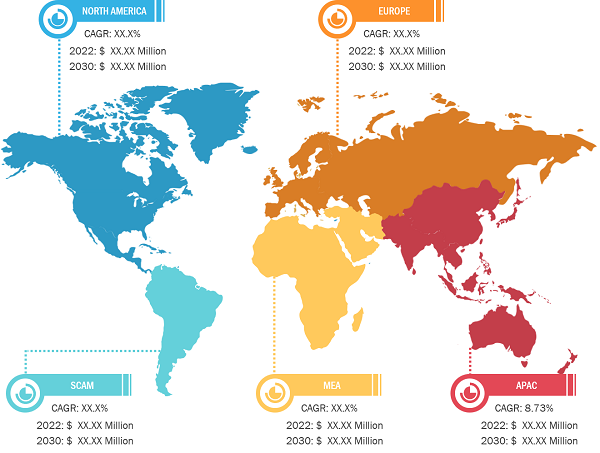Microbial Identification Systems Segment, by Type, to Dominate Microbial Identification Methods Market During 2022–2030
According to our new research study on "Microbial Identification Methods Market Size and Forecast (2020–2030), Global and Regional Share, Trends, and Growth Opportunity Analysis," the microbial identification methods market size is expected to grow from US$ 4,882.85 million in 2022 and is expected to reach a value of US$ 8,164.74 million by 2030; it is anticipated to record a CAGR of 6.64% from 2022 to 2030. Key factors driving the microbial identification methods market growth are increasing food safety concerns demanding microbial identification procedures and rising demand for microbial identification methods across various end users. However, the high cost of automated microbial identification systems and delay in the approval process of new microbial diagnostic tests due to complex regulatory framework hinder the microbial identification methods market growth.
Government initiatives and funding promoting microbial identification are crucial pillars of public health, scientific research, and industrial development. These initiatives serve a wide range of purposes, from enhancing disease surveillance and response to supporting innovative research in microbiology. In March 2023, the American Society for Microbiology (ASM) requested that Congress issue at least US$ 50.924 billion for the National Institutes of Health (NIH) and US$ 11.58 billion for the Centers for Disease Control and Prevention (CDC) in FY 2024. ASM requested US$ 175 million within the CDC budget for the Advanced Molecular Detection (AMD) program in the National Center for Emerging and Zoonotic Infectious Diseases. Moreover, governments fund academic research through grants and institutions to foster breakthroughs in microbial identification, benefiting fields such as biotechnology, pharmaceuticals, and environmental sciences. These investments also bolster food safety and agricultural practices by supporting research to detect foodborne pathogens. Furthermore, governments often collaborate with private enterprises, creating public–private partnerships that drive innovation in microbial identification technologies. Overall, these initiatives and funding mechanisms play a pivotal role in safeguarding public health, advancing scientific knowledge, and driving economic growth by underpinning the microbial identification field.
Microbial Identification Methods Market, by Geography, 2022 (%)
Microbial Identification Methods Market Size and Forecasts (2020 - 2030), Global and Regional Share, Trends, and Growth Opportunity Analysis Report Coverage: By Method (Genotypic, Phenotypic, and Proteotypic), Type (Bacterial Identification System, Microbial Enumeration System, Bacterial Resistance Identification Systems, Microbiology Analyzer, and Others), and Geography (North America, Europe, Asia Pacific, Middle East & Africa, and Latin America)
Microbial Identification Methods Market Analysis by 2030
Download Free Sample
Avantor Inc, Becton Dickinson and Co, bioMerieux SA, Merck KGaA, Thermo Fisher Scientific Inc, Bruker Corp, Shimadzu Corp, Accelerate Diagnostics Inc, Molzym GmbH & Co KG, and Biolog Inc are among the key companies operating in the microbial identification methods market. The companies have been implementing various strategies that contributed to their growth and led to various changes in the market. The companies have utilized both organic strategies (such as launches, expansion, and product approvals) and inorganic strategies (such as product launches, partnerships, and collaborations).
In April 2023, Bruker Corporation launched the fast next-generation MALDI Biotyper IVD Software and optimized MBT Mycobacteria IVD Kit and MBT HT Filamentous Fungi IVD Module. The launch is expected to complement the company's user-friendly, best-in-class diagnostic solutions for routine clinical microbiology and infection diagnostics laboratories.
The report segments the microbial identification methods market as follows:
The microbial identification methods market, by method, is segmented into genotypic, phenotypic, and proteotypic. The phenotypic segment held the largest market share in 2022. The phenotypic methods are often called the "traditional" method for microbial identification. The phenotypic method for microbial identification relies on metabolic variations across species to identify microorganisms. This method generally includes Gram staining, culture, and biochemical assays. Furthermore, the genotypic segment is anticipated to register the highest CAGR from 2022 to 2030.
The microbial identification methods market, by type, is segmented into bacterial identification systems, microbial enumeration systems, bacterial resistance identification systems, microbiology analyzers, and others. The bacterial identification system segment held the largest market share in 2022 and is anticipated to register the highest CAGR during 2022–2030. Bacterial identification systems are available in manual to automatic settings depending on the application. For example, VITEK 2, manufactured by bioMérieux SA and BD Phoenix Automated Microbiology System, is a fully automated system that performs bacterial identification and antibiotic susceptibility testing. A few application areas for bacterial identification systems are healthcare facilities, clinical labs, forensics, and pharmaceutical industries.
Based on geography, the microbial identification methods market is segmented into North America (the US, Canada, and Mexico), Europe (France, Germany, the UK, Italy, Spain, and the Rest of Europe), Asia Pacific (China, Japan, India, Australia, South Korea, and the Rest of Asia Pacific), Middle East & Africa (Saudi Arabia, South Africa, the UAE, and the Rest of Middle East & Africa), and Latin America (Brazil, Mexico, and the Rest of Latin America).
Contact Us
Phone: +1-646-491-9876
Email Id: sales@theinsightpartners.com